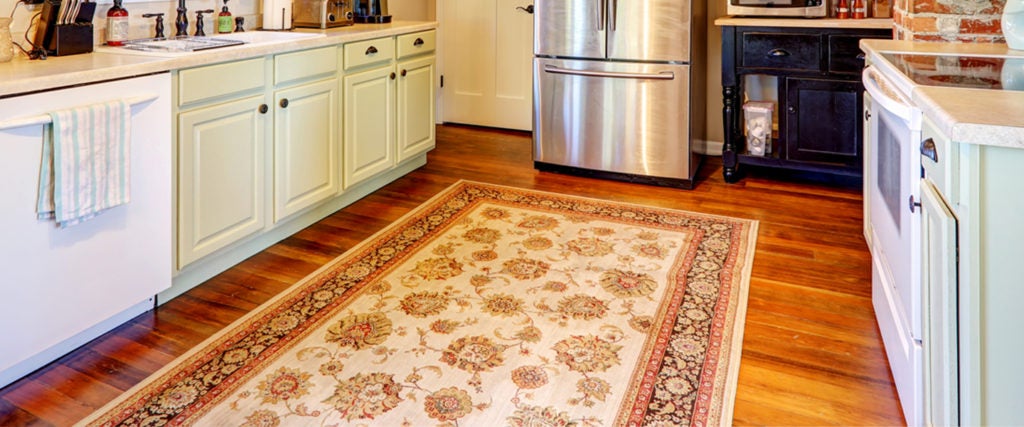Leave it to Architectural Digest to drive a wedge through America. All it took was one beautifully lit feature spread on Dakota Johnson’s home to trigger a wave of unrest across the nation. For the first time in their lives, thousands of people were confronted by a discomfiting question: Wait. People put rugs in their kitchens?
Johnson claims that she “loves” to bake and cook, and does so often, but the appearance of a Persian-style rug in her petite kitchen caught me completely off guard. Don’t get me wrong, her aesthetic is unimpeachable: The light sage green of her cabinets contrasts beautifully with the richer blues and earth tones of the rug, and I appreciate how the pattern creates texture in between a lot of sleek panels. But what happens when the pasta water boils over, or tomato sauce splatters out of a pan, or she knocks over a bottle of merlot with her elbow?
Are we to believe that Johnson has never dropped a quarter-cup of flour on the ground after tripping over her own feet? Or that the rug has been infused to the core of its fibers with some magical ability to repel everyday stains? As one perturbed redditor quipped: “Sharp knives, bubbling hot oil, scalding water… just needs a manky bit of carpet with a curled up edge to increase the difficulty level.”
Large area rugs in kitchens give me anxiety, I just know it harbors crumbs and grease
— viking barb (Ilhan Omar Stan Account) (@Willynumnum) November 23, 2020
i know everyone loves dakota johnson’s kitchen but that huge rug taking up the whole space just gives me such Bad Vibes… the worst https://t.co/1ZnPNkL1ZS
— imaan nisa (@noodleimaan) June 29, 2020
Needing clarity, I reached out to Nora Haroonian, vice president of The Rug Warehouse & More in L.A. As it turns out, the kitchen-rug trend isn’t imaginary — she’s noticed an uptick in interest and sales for just that purpose. “I think it started out with more upscale homes doing this, but now it’s pretty popular to put a runner in front of a kitchen island, a rug in the breakfast area, or by the sink,” she tells me.
A rug might appear hopelessly impractical compared to the simple hardiness of a wood, tile or linoleum floor, but Haroonian argues that an old-school rug with sturdy construction can be a useful element in a working kitchen, and not just for show. “We’re firm believers in wool being the best material for longevity and cleanability, in almost all areas of the house. And nothing beats handmade or hand-knotted. These rugs are made to last and hold up to traffic, vacuuming and cleaning much better than machine-made or tufted rugs,” Haroonian says.
Some retailers suggest that a thinner “flat-weave” rug might be a more pragmatic choice, and machine-washable rugs (already a hit with cash-strapped millennials) are a solid option for those who want zero fuss. But Haroonian suggests that synthetic materials and cheap construction will cost more in the long run, and that old-school rugs are better than people think at hiding stains and taking a beating (wool, for one, is naturally water- and stain-resistant). Taking care to not spill things is step one, she says, but adds that gentle vacuuming and spot-cleaning, along with an annual deep-clean by a reputable source, will keep a wool rug going for ages, even in the kitchen.
i just spilled hot chocolate all over my moms kitchen rug….. WHO HAS A KITCHEN RUG????
— Emma (@emmartinez321) November 29, 2020
i knocked over oat milk on one kitchen rug, cold medicine on the other rug, then a whole cup of water ?
— flat earther kitt #ACAB (@NicholeGunz) November 29, 2020
Why bother at all?
Pragmatically speaking, rugs do soften the impact of walking and standing on a hard floor, and help reduce ambient noise. Maybe more importantly, they look beautiful — far more so than the generic rubber cushion mats I have in my home kitchen. You might think that a kitchen isn’t the room for unnecessary aesthetic garnishes. But in my experience, people place more effort in how their bathroom looks than their kitchens, and that’s kind of tragic. We basically expect the kitchen to be a place of mess, chaos and stress. No wonder a kitchen rug seems almost laughably indulgent.
Yet mindset is everything when it comes to cooking, and I can’t help but think about how some of the best chefs in the world choose to use carpeted rugs in their kitchens. Thomas Keller of the French Laundry used to vacuum the carpets alongside his line cooks after every evening’s service, and spoke of it as some sort of meditative act. “When a kitchen is organized, efficient, calm and collected, there’s no frustration, anxiety or stress,” he once said. “This kitchen is magnificent. There’s carpet on the floor! If it’s a rubber mat, who cares what you throw down there. It breeds a certain sense of pride in what you’re doing.”
Perhaps a kitchen rug can make our time in the kitchen more intentional, in the same way that improving one’s knife skills changes the tenor of cooking even if the end result tastes largely the same. And if you spill on it, well, so what? I don’t see anyone tearing out their apartment’s carpet so they can better enjoy red wine and finger foods.
Let us all reconsider the kitchen rug, for both its aesthetic goodness and its symbolism. And thank you, Dakota Johnson, for redpilling me on this subject.

